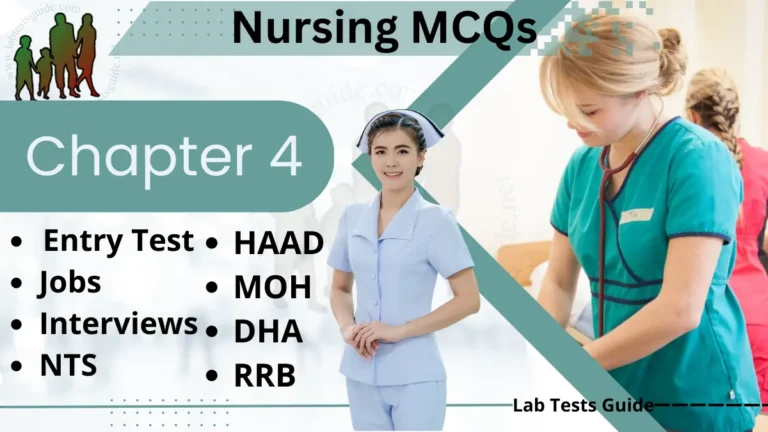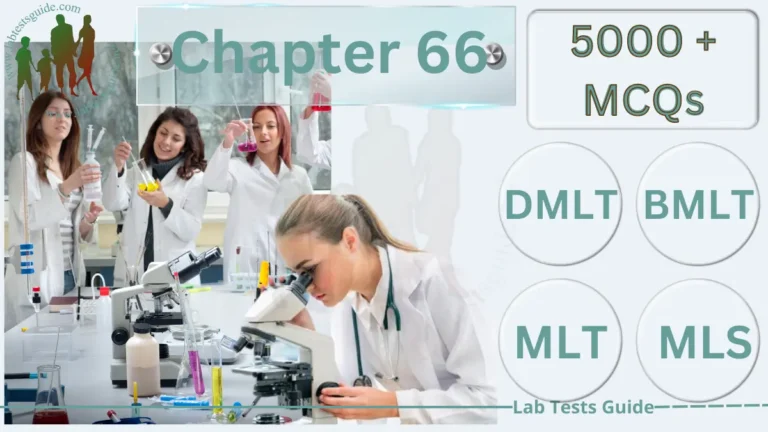5000 Plus MCQs for Lab Technician and Technologists are designed to test the knowledge and proficiency of laboratory professionals who work in the field of clinical laboratory science. These questions cover a wide range of topics related to laboratory science, including anatomy, physiology, microbiology, chemistry, and hematology.

3851 to 3900 MCQs for Lab Technician and Technologist Exam Preparation
If You like then share this to your friends and other social media.
If You have any question and suggestions then please Contact us Here
Questions 3851 to 3900
- During the preparation of aroutine H&E slide, what allows the tissue to be visualized?
A. Fixation
B. Embedding in paraffin
C. Staining ✔️
D. Slicing - Which type of cartilage forms the hammer, anvil and stirrup?
A. Hyaline cartilage
B. Elastic cartilage
C. Fibrocartilage
D. All of the above
E. None of the above ✔️ - Which of the following is an element of the central nervoussystem?
A. Receptors
B. Brachial plexus
C. Sciatic nerve
D. Ganglia
E. Spinal cord ✔️ - What is the limiting membrane of a cell?
A. Plasmalemma ✔️
B. Glycocalyx
C. Protoplasm
D. Cristae - What is the functional unit of the liver?
A. Lobule ✔️
B. Portal triad
C. Central vein
D. Hepatocyte - Which type of the following biological vectors is responsible for transmission of malarial parasite-
A. Cyclo-developmental
B. Propagative
C. Transovarial
D. Cyclo-propagative ✔️ - Which of the parasites below is NOT having any intermediate host-
A. Hymenolepis diminuita
B. Clonorchis sinensis
C. Necator americanus ✔️
D. Loa loa - Which of the following parasite DOES NOT belong to the class Coccidia-
A. Cryptosporidium
B. Isospora
C. Babesia ✔️
D. Cyclospora - Which of the following is NOT correct-
A. E. histolytica can be cultured on Boeck & Drbohlav’s diphasic medium
B. T. vaginalis can be cultured on Trussell & Johnson’s medium / CPLM
C. L. donovani can be cultured on Hockmeyer’s medium
D. T. cruzi can be cultured on Weinman’s medium ✔️ - DumDum fever is the name given to-
A. Visceral leishmaniasis ✔️
B. New world leishmaniasis
C. South American trypanosomiasis
D. East African sleeping sickness - Montenegro test is used to diagnose-
A. Kala azar ✔️
B. Ecchinococcosis
C. Chagas disease
D. Toxoplasmosis - Which of the following organisms can infect and multiply inside Protozoa-
A. Mycobacterium bovis
B. Mycobacterium avium ✔️
C. Mycobacterium xenopi
D. Mycobacterium simiae - Oocysts of which of the following parasites are infective when passed in the faeces- A) Cyclospora
cayetenensis
B. Cryptosporidium parvum ✔️
C. Isospora bellii
D. All of the above - River blindness is the name given to disease caused by-
A. Loa loa
B. Onchocerca volvulus ✔️
C. Toxplasma gondii
D. Acanthamoeba culbertsoni - Operculated eggs are seen in the following, EXCEPT-
A. Fasciola hepatica
B. Schistosoma japonicum ✔️
C. Clonorchis sinensis
D. Diphyllobothrium latum - Which species of fungus Microsporum has characteristic two celled macroconidia-
A. Microsporum gypseum
B. Microsporum audounii
C. Microsporum canis
D. Microsporum nanum ✔️ - Rose gardner’s disease is caused by-
A. Paracoccidioides brasiliensis
B. Sporothrix schenkii ✔️
C. Penicillium marneffei
D. Coccidioides immitis - Which Candida species is known to produce ‘pseudo-germ tube’-
A. C. dubliniensis
B. C. tropicalis ✔️
C. C. albicans
D. C. krusei - Which of the following fungus is NOT forming ‘sclerotic bodies’-
A. Exophiala ✔️
B. Phialophora
C. Fonsecaea
D. Cladosporium - 16- Which of the following dermatophyte is giving a positive hair perforation test-
A. Trichophyton tonsurans
B. Trichophyton schoenleinii
C. Trichophyton mentagrophytes ✔️
D. Trichophyton verrucosum - Which of the following is NOT causing eumycotic mycetoma-
A. Pseudoallescheria boydii
B. Exophiala jeanselmei
C. Acremonium kifience
D. Actinomadura ✔️ - Dichotomously branching septate hyphae are characteristically seen in-
A. Aspergillus spp ✔️
B. Rhizopus spp
C. Mucor spp
D. Absidia spp - ‘Spaghetti & meat balls’ appearance of fungal elements in 10% KOH are characteristics of-
A. Hansenula anomala
B. Saccharomyces cervisiae
C. Malassezia furfur ✔️
D. Exophiala werneckii - Which of the following agent is a fungus-
A. Pneumocystis jeroveci ✔️
B. Cryptosporidium parvum
C. Eikenella corrodens
D. Ehrlichia chaffeinsis - ‘Hulle cells’ are the characteristic of-
A. Aspergillus fumigates
B. Aspergillus nidulans ✔️
C. Aspergillus terreus
D. Aspergillus flavus
- In a case of meningitis a normal glucose level in C.S.F. suggests-
A. Bacterial etiology
B. Mycobacterial etiology
C. Viral etiology ✔️
D. Fungal etiology - Which of the following is NOT true about Staphylococcus saprophyticus-
A. Commonly causes UTI in young, sexually active, young females,
B. It is sensitive to Novobiocin ✔️
C. It is coagulase negative
D. It is modified oxidase test negative - Griffith’s serotyping of ß-hemolytic streptococci is based on-
A. Cell wall carbohydrate C antigen
B. Cell wall M protein ✔️
C. Cell wall peptidoglycan
D. Cell wall murein - Which of the following is NOT true of B.anthracis-
A. It produces Medusa head colony
B. It gives positive M’Fadyean’s reaction
C. It is used as an agent of bioterrorism
D. It produces a potential endotoxin ✔️ - Spores of which species of Bacillus is used as a biological control in autoclaves-
A. B. megaterium
B. B. thuringiensis
C. B. stearothermophilus ✔️
D. B. anthrasis - Which clostridial species has subterminal endospores-
A. C. tetani
B. C. tertium
C. C. septicum ✔️
D. C. ramosum - A reverse CAMP test is positive in-
A. C. tetani
B. C. perfringens ✔️
C. C. difficile
D. C. novyi - Causative agent of granuloma inguinale is-
A. Chlamydia trachomatis
B. Klebsiella rhinoscleromatis
C. Mycoplasma homonis
D. Klebsiella granulomatis ✔️ - Pseudohemoptysis is due to-
A. Pyomelanin
B. Diphthericin
C. Prodigiosin ✔️
D. Fumonisin - Which of the following specimen is NOT suitable for anaerobic culture-
A. Blood
B. Culdocentesis aspirate
C. Throat swab ✔️
D. Peritoneal fluid - Which of the following is NOT a constituent of bacterial cell wall-
A. N-acetyl muramic acid
B. N-acetyl glucosamine
C. N-Acetyl-L-cysteine ✔️
D. Teichoic acid - Which of the following is NOT true-
A. Transposons are extrachromosomal genetic elements
B. Transposons are known as jumping genes
C. Transposons can transfer genes of chromosomes
D. Like plasmids they exist independently and are self replicating ✔️ - Non-specific urethritis may be caused due to the following, EXCEPT
A. Ureplasma urealyticum
B. Gardnerella vaginalis
C. Candida albicans
D. Actinobacillus hominis ✔️ - Which of the following is NOT true of Listeria monocytogenes-
A. It does not survive inside phagocytes ✔️
B. It gives a positive Anton’s test
C. It has tumbling motility at 250C
D. It gives a positive CAMP test - Which of the following is TRUE of the Corynebacterium diphtheriae-
A. It produces diphtheria toxin because of phage
B. Toxin production is influenced by Mg++ concentration in the medium
C. Toxin mainly affects lungs and kidneys
D. Toxigenicity can be demonstrated in tissue culture ✔️ - Culture of anaerobic organisms can be done by all ,EXCEPT-
A. Gas-Pak
B. Candle jar ✔️
C. McIntosh & Fildes jar
D. Thioglycollate broth - Which of the following is NOT true of the Entero Haemorrhgic E.Coli(EHEC)-
A. The most common serotype is O157: H7
B. It can cause Hemolytic Uremic Syndrome
C. It ferments Sorbitol sugar in the medium ✔️
D. It produces toxin which is toxic to HeLa cell lines - Shigellosis includes all of the following, EXCEPT-
A. Hemolytic Uremic Syndrome
B. Gay-bowel syndrome
C. Fitz-Hugh-Curtis syndrome ✔️
D. Intussusception of bowel - According to current W.H.O. classification of genus Salmonella, there are mainly two species-
A. S. enterica & S. arizonae
B. S. arizonae & S. enteritidis
C. S. bongori & S. enterica ✔️
D. S. bongori & S. typhi - Gram stained smear of Vibrios in mucus flakes of stool specimen resembles-
A. School of fish appearance
B. Fish in stream appearance ✔️
C. Sea-gul appearance
D. String of pearls appearance - Which of the following organisms is responsible for Brazillian Purpuric Fever(BPF)-
A. Hemophilus hemolyticus
B. Hemophilus aphrophilus
C. Hemophilus aegyptius ✔️
D. Hemophilus parainfluenzae - Which of the organisms below does NOT liquefy gelatin-
A. Morganella morganii ✔️
B. Bacillus subtilis
C. Proteus vulgaris
D. Staph.aureus - Which one of the following are NOT related to each other-
A. Nagler’s reaction & Clostridium perfringens
B. Nissl’s bodies & Polio virus
C. Tunica reaction & Rickettsia prowazekii ✔️
D. Rat bite fever & Streptobacillus moniliformis - Which of the following is NOT commonly seen in HIV infected patients-
A. Bacillary angiomatosis
B. Generalised Strongyloidiasis
C. Cryptosporidiosis
D. Leptospirosis ✔️ - Which of the following organisms is NOT associated with bloody diarrhea-
A. Shigella dysenteriae
B. Campylobacter fetus ✔️
C. Clostridium difficile
D. B.anthracis
The questions are typically designed to assess the technical skills and knowledge required for the laboratory profession, including the ability to analyze laboratory test results, perform laboratory procedures, and maintain laboratory equipment.
To prepare for these MCQs, candidates should have a thorough understanding of the key concepts and principles of laboratory science. They should also be familiar with common laboratory equipment and procedures, as well as laboratory safety protocols.
Candidates may also benefit from studying specific laboratory science textbooks or taking online courses that cover the material tested in the MCQs. Additionally, practicing sample MCQs and reviewing the answers can help candidates identify areas where they may need to improve their knowledge or skills.
Overall, the MCQs for lab technologists are designed to be challenging and comprehensive, requiring candidates to demonstrate a high level of proficiency in the field of laboratory science.
Possible References Used







